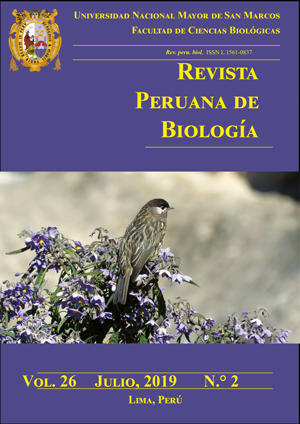Pleistocene Fossil Turtles (Testudinoidea, Cryptodira) from the Talara Tar Seeps, Peru
DOI:
https://doi.org/10.15381/rpb.v26i2.15118Keywords:
Testudines, Geoemydidae, Testudinidae, Pleistocene, PaleobiodiversityAbstract
A description of Pleistocene fossil turtles discovered in the Talara Tar Seeps, Tablazos deposits of the northern coast of Peru is provided in this paper. The specimens are mostly fragmentary plates of carapaces and plastra of turtles belonging to two cryptodiran families of the superfamily Testudinoidea, identified to genus level based on measurements and comparisons with extant and fossil taxa and identification of mosaic diagnostic features. Turtles of the Geoemydidae family are the most abundant, with fossil remains attributed to Rhinoclemmys (indeterminate species). Less abundant fossil remains belong to the Testudinidae, with specimens attributed to the genus Chelonoidis (indeterminate species). These fossils show that the northern coast of Peru had ecosystems that supported abundant aquatic and terrestrial turtles (tortoises) during the Pleistocene in areas where they are completely absent today.
Downloads
Downloads
Published
Issue
Section
License
Copyright (c) 2019 Anthony Deza, Edwin Cadena, Jean-Noël Martinez

This work is licensed under a Creative Commons Attribution-NonCommercial-ShareAlike 4.0 International License.
AUTHORS RETAIN THEIR RIGHTS:
a. Authors retain their trade mark rights and patent, and also on any process or procedure described in the article.
b. Authors retain their right to share, copy, distribute, perform and publicly communicate their article (eg, to place their article in an institutional repository or publish it in a book), with an acknowledgment of its initial publication in the Revista Peruana de Biologia.
c. Authors retain theirs right to make a subsequent publication of their work, to use the article or any part thereof (eg a compilation of his papers, lecture notes, thesis, or a book), always indicating its initial publication in the Revista Peruana de Biologia (the originator of the work, journal, volume, number and date).






